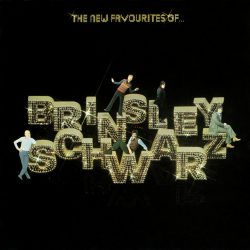 Brinsley Schwarz have a special place in the formative years of British americana. Taking their name from guitarist Brinsley Schwarz, the band were formally known as Kippington Lodge. The early years of the band were somewhat dogged by the reputation of their much hyped, but unsuccessful, launch gig at Fillmore East in New York in 1970, opening for Van Morrison and Quicksilver Messenger Service.
Brinsley Schwarz have a special place in the formative years of British americana. Taking their name from guitarist Brinsley Schwarz, the band were formally known as Kippington Lodge. The early years of the band were somewhat dogged by the reputation of their much hyped, but unsuccessful, launch gig at Fillmore East in New York in 1970, opening for Van Morrison and Quicksilver Messenger Service.However, by the time that ‘The New Favourites of … Brinsley Schwarz’ was released in 1974, the band had earned a fine reputation as a gigging band, as part of the London pub rock scene, and had recorded a series of well-regarded albums, notably ‘Nervous on the Road’ released in 1972. ‘The New Favourites of … Brinsley Schwarz’ was their sixth studio album, and destined to be the last they released, before disbanding in March 1975.
Band members Brinsley Schwarz on guitar, Nick Lowe on bass, guitar and vocals, Bob Andrews on keyboard and Billy Rankin on drums were ever present members of the band, joined by Ian Gomm in 1971.
The early albums were much influenced by The Band but ‘New Favourites’, produced by Dave Edmunds, was both more energetic and more polished. Opening track ‘(What’s So Funny ‘Bout) Peace, Love and Understanding’ written by Lowe subsequently became his most commercially successful song, later recorded by Elvis Costello, and notably by Curtis Stigers, this version appearing on the soundtrack album to ‘The Bodyguard’. The substantial songwriting royalties which followed enabling Lowe to relaunch his solo career with the sequence of albums later to be known, and rereleased, as the Brentford trilogy (‘The Impossible Bird’, ‘Dig My Mood’ and ‘The Convincer’).
Still a staple of Lowe’s live sets, the first recorded version of the song is a fine opener to the album, with big strummed chords, pounding drums from Rankin, a memorable piano motif from Andrews, epic backing vocals on the chorus, multi tracked guitar solo, and a classic production touch — vocal harmonies on ‘harmony’ on the line’ “And where is the harmony, sweet harmony”.
Edmunds production gives a vibrancy to the album throughout, and the collaboration launched with Lowe was one to endure through the subsequent Rockpile era. Lowe is credited as songwriter on eight of the album’s ten tracks, with credit shared with Gomm on ‘I Got the Real Thing’ and ‘I Like You, I Don’t Love You’ while Schwarz shares co-writing credits on closing track ‘Down at the Dive’.
Lowe’s songwriting comes to the fore throughout the album, displaying the ability to synthesise his many musical influences which served him so well in his subsequent solo albums, and work with Rockpile. He has been heard to describe himself as a “musical magpie“, and the album blends many musical styles but with his, and the band’s, own distinctive take. One notable influence is the soul/country soul sound of Muscle Shoals, with saxophone (credited to Bob Andrews and Brinsley Schwarz) prominent throughout. On ‘Ever Since You’ve Been Gone’ sax features prominently, with backing vocals echoing the lead line in the chorus,while on ‘I Like You, I Don’t Love You’ again with prominent sax, the backing vocals anticipate, rather than follow, the lead vocal line – a classic soul feature.
‘I Got the Real Thing’ with a funky, bluesy baseline throughout has an early Motown feel, while ‘The Ugly Things’ could be an early Beatles track, midtempo with a melodic guitar riff, and with Bob Andrews characteristic keys providing tasty fills at the end of each vocal line. The same fills from Andrews feature on sensitive ballad ‘The Look That’s in Your Eyes Tonight’ with a distinct nod to the Everly Brothers, longtime favourites of Lowe.
In his later solo work Lowe has demonstrated a great knack of picking just the right songs to cover – usually one or two per album. Here, ‘Now’s the Time’, an Allan Clarke and Graham Nash composition, is a fine introduction to side 2, featuring ringing guitar chords, and harmony vocals from the get go.
The second cover, ‘Tryin’ to Live My Life Without You’ is the band’s own take on a song first recorded by Otis Clay in 1972, Featuring fine work on keys again from Bob Andrews, and another melodic guitar line from Brinsley Schwarz, the song was to be covered again later by Bob Seger in 1981, and Dr. Feelgood in 1982 – doubtless due to Lowe’s subsequent work with the band, as producer.
Closing track ‘Down at the Dive’ starts and closes with the sounds of the crowd at the dive – the place where the “coolest cats in town“ are to be found. Here the repeated sax line is multitracked, with the lengthy instrumental section featuring a spoken part, as the tension builds over the repeated sax riff. The lyrics reference James Brown and the Temptations, and the track also features a psychedelic space age effect, as per the Temptations psychedelic side. Again, that musical magpie…
Although a further album, ‘It’s All Over Now’ was recorded in 1974 Its release has only come in recent years, ‘New Favourites’ being their last release before splitting up. Nick Lowe continued his collaboration with Dave Edmunds in Rockpile, following several successful solo albums; while Bob Andrews and Brinsley Schwarz formed the nucleus of the Rumour, best known for their work with Graham Parker. And of course Nick Lowe’s critically acclaimed career as a writer and performer continues to this day.
A very fine album indeed, to sign off the band’s career, still sounding fresh and vibrant today.



Great review, still sounds so fresh! Just had to add the album to my iPod!